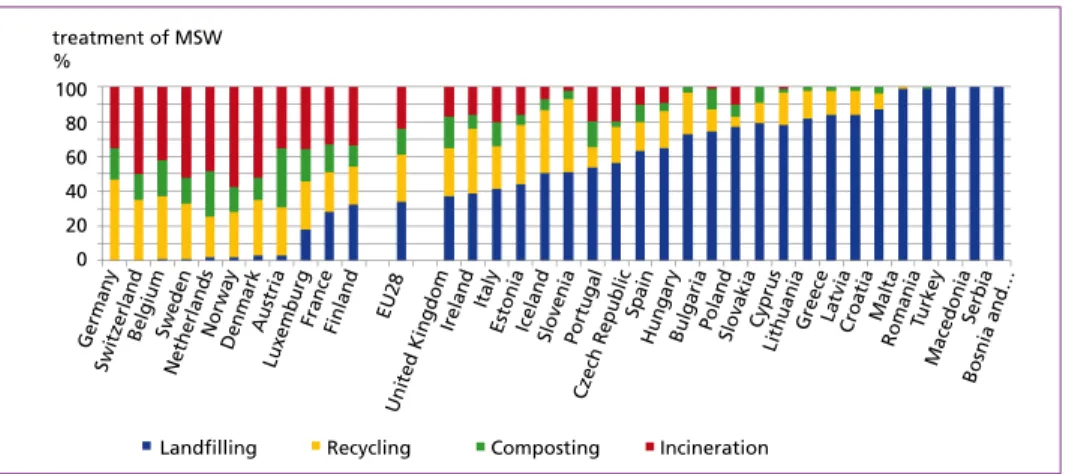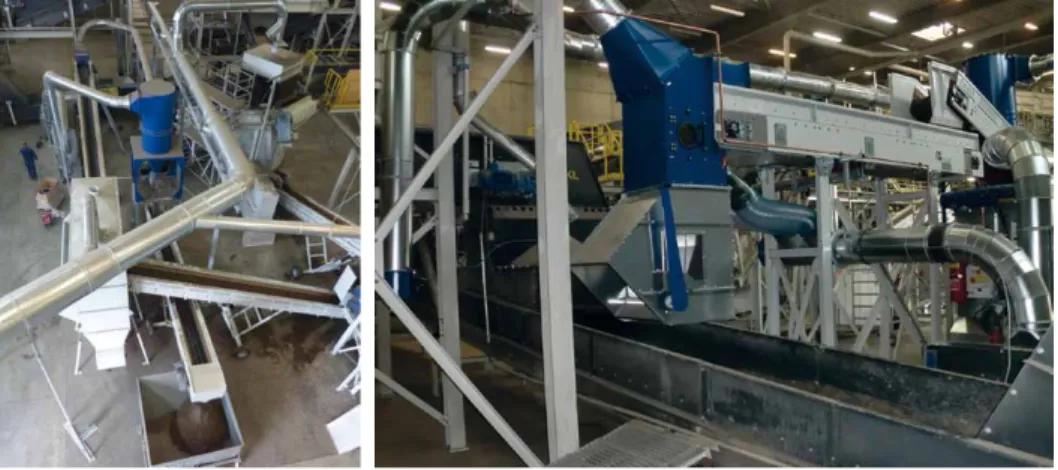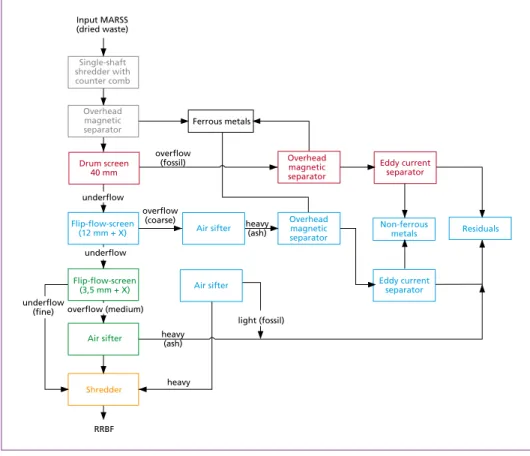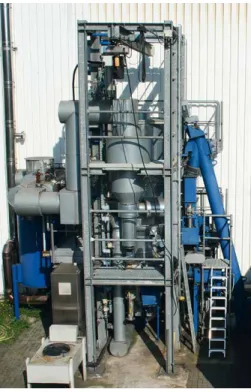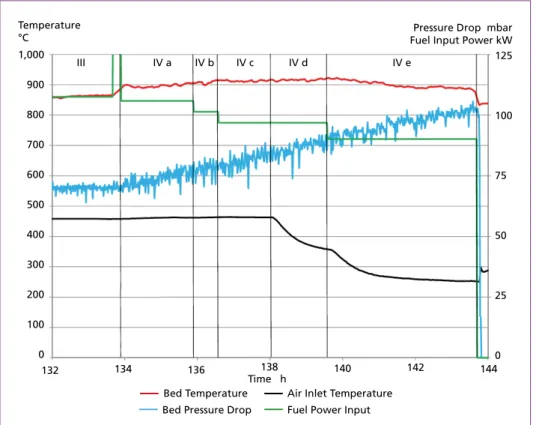MBT and SRF
Mechanical-biological Stabilization Plant in Trier
– Biological Drying and Recovery of Recyclable Materials –
Maximilian-G. Monzel, Kate Hornsby and Thomas Pretz
1. Introduction ...376
2. MARSS project description and technology ...379
3. Details of the MARSS demonstration modular plant ...381
4. RRBF biomass fuel ...382
5. Conclusions and outlook ...384
6. References ...385
In spite of the fact that the EU has set up a waste hierarchy and issued key pieces of waste management directives, and ratified by all EU member states, compliance with diversion targets away from landfilling are still considered too ambitious and are far out of the reach of many EU countries. This is especially true for the southern European and Eastern European Member States, who are looking for viable economic and robust technologies that be rapidly implemented assisting them to fulfil EU targets within the desired timeframes. In the wider context, growing concerns about the increasing resource demand by society and the poor way society has been dealing with waste and natural resources call for increased attention to waste management practises by local and regional authorities. Landfilling and incineration, the most common practices for waste management worldwide, are not universally seen to be an acceptable or affordable solution in many EU countries with consumer resistance often causing conflicts with decision makers, who have the responsibility to try to find an economic workable so- lutions for that location and culture. The targets set by the EU to reduce landfilling are not being reached. In addition, trends in the EU are requiring member states to adopt ever more complex and costly separate collection systems of recyclables, and putting more responsibility for correct separation on the householders adding significant costs and infrastructure investments across the board in what are mostly strapped for cash municipalities in many European countries. This paper addresses the urgent search for viable solutions to enable municipalities to quickly implement advanced waste management strategies based on technological innovation and stakeholders acceptance.
The proposed advanced MBT modular plant is partially funded by the EU LIFE Plus program known as MARSS, deals with an innovative recycling plant to extract useful waste fractions still available in the municipal solid waste after biological drying and
MBT and SRF
mechanical pre-sorting. A 10 tonnes per hour waste stream is being processed to pro- duce a high quality biomass refuse recovered biomass fuel (RRBF) concentrated in the fraction < 40 mm. The demonstration MARSS project (www.marss.rwth-aachen.de) covers the technical production of RRBF, is built as an additional modular plant to an existing Mechanical Biological Treatment (MBT) plant in Trier, supported by combus- tion tests and certification of the renewable fuel by UMSICHT, a Fraunhofer Institute.
This project is not simply about the development and testing of a new technology process, but also embraces integrated monitoring and impact assessment, combining the fields of innovative process engineering, environmental Life Cycle Analyses (LCA), multi-criteria socio-economic analyses, and cross-cultural stakeholders participatory strategies in different EU countries.
In addition, successful demonstration results are suggesting a one size fits all viable al- ternative to the standard EU Waste Management programme, namely that it is possible for mixed household rubbish to be collected in one bin, naturally dried, mechanically processed to produce recycled secondary materials with the bonus that a quality CO2 neutral RRBF is produced, opening up new opportunities for additional sources for renewable heat and power for use in local communities.
1. Introduction
Concerns about climate change and the effects of waste management on the environ- ment and the failure of some member states to reach the targets set by the EU legislation are becoming more pressing in recent times. The EU Landfill Directive has underlined the importance of reducing the amount of untreated MSW going to landfill with a focus on the reduction of landfilled organic matter as being one of the main sources of harmful greenhouse gas emissions in the form of methane. The EU Landfill Directive is particularly concerned with requiring all member states to comply across the board with the set targets for the reduction of biodegradable municipal waste (BMW) being sent to landfill. Biodegradable waste is defined in the Directive as ‘waste that is capable of undergoing anaerobic or aerobic decomposition, such as food and garden waste, and paper and paperboard’.
There is much uncertainty about the quantity of BMW in the EU. It is estimated that 60 to 70 percent of MSW in most countries is made up of biodegradable elements (data taken from the EC Factsheet 6: Landfill Diversion 2012). The main aim of the EU le- gislation dealing with waste is to encourage and lead the whole of Europe and different member states towards a common path and uniformity of waste management with set targets and different time frames with the final aim to minimize landfill as much as possible. However, given the right support, the proper implementation of the waste hierarchy, waste targets, waste management plans and waste prevention programmes as set out in the revised Waste Framework Directive should lead to further moves away from land filling but the success of reaching the deadlines set for diversion targets is still under debate. The EU27 still shows a radical diversity in how much landfilling is still used as a major option for waste management in spite of the EU Landfill Directive and agreed diversion targets.
MBT and SRF Figure 1: Reliance on landfilling in the EU 27 member states
Figure 1 shows the different rates of recycling and composting, incineration and land- filling in EU 27.
One can say that Germany fulfills the Landfill Directive, followed closely by the Nether- lands, Belgium, Sweden, Austria and Denmark however many other member states are way behind the expected and set targets and many do not have access to the relatively expensive incineration technologies and mostly rely on landfilling with low expecta- tions of speedy change. Many European communities have very different historical and economical paths, and are currently facing serious financial difficulties so do not have the resources or capacity to realistically bring the wished for by EU legislation change and innovation into their waste management strategies.
The choice of waste management strategies and technologies to reach the EU targets is very different even within those countries seen as being successful in reducing landfil- ling such as Germany and the Netherlands for example. In the early 1990‘s, Germany took the decision to solve the problems of MSW treatment mainly via expensive high-tech incineration. At that time, CO2 emissions from plastic combustion were not under direct scrutiny and climate change was not considered as an urgent issue as it is today. A decision was taken finally in June 2005 that no more biological fractions should go to landfill and the preferred route at that time was to use incineration. This encouraged new ideas and technical testing of MBT technologies for waste to energy, however adoption levels are very different in the different states in Germany. The MBT market in Germany is considered now to be mature, and no more extensive expansion anticipated, with an established pricing structure and the local authorities still have control over the purse strings.
Both countries legally require separate collection systems, together with one bin for mixed MSW, but have different political local drivers even though both comply with EU legislation. The Netherlands accepts and plans for very different types of householders and locations accepting that in many areas it is not possible to get a good separation rate at the house hold levels, so provide a single bin for mixed MSW going to advanced MBT recycling plants; whereas Germany is now pushing for uniformity across the board and is even introducing a further bin for organic waste from households.
treatment of MSW
% 100
80 60 40 20 0
Landfilling Recycling Composting Incineration Germany
Switzerland Belgium Sweden
Netherlands NorwayDenmarkAustria
Luxemburg France Finland EU28
United Kingdom Ireland
Italy
Estonia IcelandSloveniaPortugal Czech Republic
Spain
HungaryBulgariaPolandSlovakia CyprusLithuaniaGreece LatviaCroatia Malta RomaniaTurkey
Macedonia Serbia
Bosnia and…
MBT and SRF
The pragmatic approach of the Netherlands accepts that it is often not possible to rely on different households and locations (rural verses cities) and additionally saves on the costs for separate collection not to mention the extended infrastructures and ad- ditional investments in vehicles and manpower that go with the multiple bin systems.
The push towards the removal of organic kitchen waste from mixed rubbish started quite early in the early 2000’s in Germany and current moves to eliminate all organic fractions from mixed waste via household collection in a separate bin for production of compost or biogas, may also have some implications for the future running of the 48 MBT plants in Germany. These plants rely on the organic fraction within the mixed MSW to provide the conditions for the natural drying process of the waste which is an important part of the stabilization of the waste before mechanical processing and recycling steps. However analyses carried out by I.A.R. RWTH Aachen University in collaboration with RegEnt GmbH have shown that in spite of pushes towards separate collection of organic material from households, this might not actually dramatically affect the composition of MSW and hence MBT plants that depend on the biological fraction for natural drying processes as shown in Figure 2, and is not thought to dra- matically affect the efficiency of the MARSS technology.
Composition of mixed MSW
% by mass 100
80 60 40 20
0 Status Quo After separate
collection of biowaste 12
57
13 52
Residuals low CV Metals
Residuals high CV
Plastics Biomass
Figure 2:
Influence of separate collection systems on composition of MSW Germany is still considered to be one of the leading countries in advanced waste ma- nagement, and based on the background of EU legislation as well as national preferences, the current reality is that households have the first responsibility to sort out their waste into a multiple set of different bins for separate collection and recycling, with the rest going into one grey bin for mixed rubbish. Consumers pay by weight and/or volume of bin for this collected mixed rubbish bin however the drive now is to further separate out the organic fraction mainly made of food waste out of this grey bin into another single bin for separate collection and processing.
In comparison to Germany, many EU countries have only just started (or even not yet) to decide on and set up their waste management systems to reach diversion and recycling targets and are looking for ways to comply with the Landfill Directive as fast as possible. These countries still have the option to adopt more sustainable, economic
MBT and SRF
and environmentally friendly treatment options for dealing with mixed MSW as they are only just starting down the path towards an integrated waste management system.
This was the one of the key motivations that the operating company RegEnt GmbH together with RWTH Aachen University set up the demonstration project concept, known as MARSS, together with their partners the Autonomous University of Bar- celona and Parthenope University of Napoli, followed by the successful 2011 applica- tion of funding from the EU Life Plus funding programme to show that the MARSS technology could provide these countries with a viable alternative to landfilling and expensive incineration based on advanced material recovery process that is do-able, robust, economic and can be quickly implemented. In addition to the material reco- very of metals (both ferrous and non-ferrous), this new process is designed with the inclusion of further processing steps of pre-sorting and refining in order to produce a high quality CO2-neutral natural-sources biomass fuel for energy recovery in Combined Heat and Power plants (CHP).
2. MARSS project description and technology
The Material Advanced Recovery Sustainable Systems (MARSS) project is now in the last year of operation and officially started in September 2012 and will end 31st December 2015. The technical aim of the project is to demonstrate and assess the production of a renewable biomass solid fuel from mixed municipal solid waste (MMSW). A consor- tium of 5 partners, including a public authority, 2 enterprises and 3 universities from 3 European countries have joined together to design, build, monitor and analyse results from this innovative plant located in Trier in Rheinland-Pfalz in Germany.
This EU Life Plus co-funded project is taking place on the premises of Entsorgungs- und Verwertungszentrums (EVZ) in Mertesdorf, in Germany. Additional project partners are RWTH University of Aachen (acting as coordinator), pbo GmbH acting as the en- gineering company, as well as the Universitá degli Studi di Napoli and the Universitat Autónoma de Barcelona who carry out the integrated assessments.
The input material for the MARSS demo plant comes from the adjacent mechani- cal biological treatment plant (MBT) in Mertesdorf, Germany. Figure 3 shows the
RegEnt MBT plant in Mer- tesdorf, which also houses the MARSS plant as part of the advanced recycling processing system.
Figure 3:
The MBT plant and site of the MARSS plant in Mertesdorf, Germany
MBT and SRF
The MBT plant is owned by the operating company and has been in operation since 2007, using the Herhof bio-drying technology, to process some 225,000 tonnes of re- sidual mixed municipal solid waste (MMSW) produced by 532,000 inhabitants each year from households in the city of Trier and surrounding regions. The area also has to deal with the additional waste produced annually by 2.2 million tourists giving over 7.2 million guest night per year. The area of collection is about 4,900 km2. In this process, the MMSW is stabilized through aerobic biological treatment steps in rotting boxes to produce high calorific refuse derived fuels (RDFs) as seen in Figure 4.
As already stated, one of the main goals of the MARSS project is to provide demonstrable evidence of a workable recycling technology to provide different European commu- nities one possible environmentally friendly alternative to fulfil European Legislation on landfilling, so helping to reach diversion targets to reduce the amount of biogenic material going to landfill. The MARSS project results do in fact demonstrate that it is possible to reach this target within the demonstration project showing the success of such a innovative recycling modular plant based on the MBT technology.
Exhaust Air Evaporation
Cooling Water
Cooling
Condensate
RTO
Exhaust air treatment in the regenerative-thermal oxidation Seepage water
Figure 4: Impression of the rotting box system used in the RegEnt MBT plant
Figure 5: Photos showing the air sifter used in the MARSS plant
MBT and SRF
Apart from demonstrating an efficient separation MBT process to deal with mixed MSW, a high quality (up to 96 percent) Refined Renewable Biomass Fuel (RRBF) from dried Mixed Municipal Solid Waste (MMSW) has also been confirmed from the fraction
< 40 mm mixed MSW. Two images are presented of the working MARSS plant in Figure 5 showing the air sifter and conveyor belts.
3. Details of the MARSS demonstration modular plant
The MBT plant is fully functioning and is currently drying and processing about 220,000 tonnes of mixed MSW per year collected from 532,000 inhabitants in and around the Trier region. The dried MMSW output material of the MBT plant is being fed into the MARSS demonstration plant via a by-pass with a capacity of about 10 tonnes per hour. The organic materials contained in the material are enriched and cleaned by a cascade of mechanical classification and separation steps.
A side stream of about 10 tonnes per hour is taken from the main MBT plant and is processed in the separate MARSS processing line to produce a quality biogenic solid dry fuel for energy production in biomass Combined Heat and Power plants. Research carried out prior to building the plant showed that the MMSW must be taken through a series of cleaning and recovery steps to remove the heavy materials, other contami- nants such as metals (ferrous and non-ferrous), stones, glass and plastics so that the final concentrated organic fraction can meet the quality for combustion in biomass plants and therefore be used as a commercial refined renewable biomass fuel (RRBF) with less than 5 percent contaminants. Further analyses are being carried out in the project to obtain accurate information about the right calibration of the system steps to enrich the organic fraction of biogenic origin and to ensure it`s use as a suitable biomass fuel with a final marketable quality for biomass power plants for local decen- tralised production of heat and power. The preliminary results of the testing campaign carried out by I.A.R. RWTH Aachen University in 2014 indicate that the majority of the biodegradable fraction is concentrated in the < 40 mm fraction.
The demo-plant was designed and built as a modular plant, on the basis of the advan- ced engineering plans submitted by pbo GmbH as well as the additional optimisation by I.A.R RWTH found to be required after testing and material characterisation of samples from input materials.
The plant is designed to be partly mobile so that the assembly or maintenance of some conveyor belts and screens can be carried out without major effort. Furthermore, one feed hopper enables the reapplication of intermediate goods. Through this flexible modular plant, several different treatment processes can be simulated and repated if necessary. This is the reason why the process can be adjusted in accordance with fluctuations in the range and characteristics of the input material.
The plant is operating batch-wise to avoid the acquisition of several air sifters and supporting units (reduction of costs). Furthermore it generates a maximum amount of useful information about the complex processes employed with minimal machine expenditure and floor space requirement. The grain size fraction 12 to 40 mm for in- stance is separated twice with the air sifter (1. sighting = reduction of ash, 2. sighting
= reduction of fossil material).
MBT and SRF
Moreover sampling stations were implemented at every essential part of the process to ensure a fast and effective sampling. The most important parts of the process and their modes of operation are listed in the flow-chart (Figure 6).
Input MARSS (dried waste)
Single-shaft shredder with counter comb
Ferrous metals Overhead
magnetic separator
Drum screen 40 mm
overflow
(fossil) Overhead
magnetic separator
Eddy current separator
Flip-flow-screen
(12 mm + X) Air sifter
overflow
(coarse) heavy
(ash)
Overhead magnetic separator
Non-ferrous
metals Residuals
Eddy current separator Flip-flow-screen
(3,5 mm + X)
Air sifter
Air sifter
heavy (ash)
heavy Shredder
RRBF underflow
(fine)
light (fossil) underflow
underflow
overflow (medium)
Figure 6: Flow chart fuel production
By additional further steps, it is possible e.g. to increase the heating value of the group size 4 to 11.5 mm fraction up to 13.800 kJ/kg. (Giani et al, 2014 MARSS results).
4. RRBF biomass fuel
The produced fuel is being tested in a combustion research institute (UMSICHT – Fraunhofer Institute) in a 100 kW combustion unit based on a fluidised bed technology (Figure 7) as well as in chosen industrial biomass heat and power plants in order to ascertain and reach required levels of quality and performance.
The combustion of RRBF has been tested in the small scale bubbling fluidized bed ga- sification/combustion test rig as shown in Figure 7. The reactor has an inner diameter of 400 mm in the lower part (bubbling fluidized bed) and 600 mm in the upper part (free-board). The height of the lower part is 1.4 m and that of the upper part 1.7 m.
MBT and SRF
The vessel is thermally insulated by a refrac- tory lining, which comprises of three layers of different materials with an overall thick- ness of 300 mm. Outside the reactor vessel, an additional 100 mm of rock wool has been are installed for better thermal insulation.
The maximum allowed temperature of the refractory lining is 1,050 °C, which limits the combustion temperature to about 950 °C (for sufficient long-lasting protection of the lining). The reactor is equipped with 8 temperature sensors over the reactor height and 7 differential pressure measurements against reactor exit pressure. The latter allows the detection of fluidized bed height by the axial pressure profile. The flue gas from the combustion unit leaves the reactor through a cyclone, where most of the fly ash is separated and collected in a small bin, which must be emptied repeatedly, depen- ding on the amount of ash. To secure full combustion, the gases pass through a com- bustor equipped with a natural gas burner.
Figure 7: The 100 kW combustion unit at UMSICHT, Fraunhofer Institute
The development of charakteristic parameters during the combustion periods is shown in Figure 8.
RRBF combustion in the testing unit has been monitored and the following results were obtained.
Three different campaigns are being carried out in the project life time to cover diffe- rences in fuel composition and drying efficiency depending on the season. The analysis of input RRBF material and combustion behaviour results are summarised below:
• Continuous feeding of the MARSS RRBF fuel into the test unit successful due to good material properties of the fuel after optimisation,
• Combustion at constant temperature of 900 °C demonstrated,
• Heating value RRBF >12 MJ/kg,
• Carbon about 35 percent, Volatiles about 66 percent,
• Ash content of about 25 percent,
• Phosphorus levels about 2300 ppm
• Purity of RRBF most likely > 95 Ma.-percent,
• Combustion tests plus material characterisation to end 2015.
MBT and SRF
Results confirm that the RRBF produced by the MARSS plant is of a suitable quality to be used as a biomass fuel using small fluidised bed combustion units up to 10 to 20 MW plants. That means that this technology is especially suitable for production of decentralised renewable energy production on a small scale in local communities.
5. Conclusions and outlook
The combination of the demonstration of the MARSS technology using MBT processes as a pre-treatment to improve the quality and characteristics of input material to the modular plant, together with the further utilisation of the RRBF for renewable energy production provides a realistic and economic alternative for local authorities EU wide and helps communities to reach diversion targets reducing mixed MSW going to landfilling as well as to provide an effective recycling process for waste management companies. Current results show that at least 35 percent of the dried MSW can be enriched to produce a biomass fuel. The combustion behaviour of the RRBF is shown to be comparable to wood-based biomass fuels. Results from case studies carried out in Naples within the framework of the MARSS project have shown that the consumers tend to prefer such an alternative to incineration and/or landfilling. In addition, results
Temperature
°C 1,000
900 800 700 600 500 400 300 200 100 0
Pressure Drop mbar Fuel Input Power kW 125
100
75
50
25
0
Bed Temperature Air Inlet Temperature Bed Pressure Drop Fuel Power Input
Time h
132 134 136 138 140 142 144
III IV a IV b IV c IV d IV e
Figure 8: Development of characteristic parameters during combustion periods
MBT and SRF
from analyses carried out by the Fraunhofer Institute have shown that even the ashes from combustion campaigns contain useful products like phosphor at reasonable levels for recycling and re-use and offer up further opportunities for the MARSS RRBF such as co-combustion with sewage sludge, also an interesting future opportunity for EU27.
Acknowledgements The authors gratefully acknowledge the financial support received from the EU Project LIFE11 ENV/DE/343, MARSS Material Advanced Recovery Sustainable Systems, LIFE+
Environment Policy and Governance.
6. References
[1] Achterkamp, M.; Vos J.; (2007): Critically identifying stakeholders. Systems Research and Be- havioral Science: 3 – 14
[2] Arbeitsgemeinschaft Stoffspezifische Abfallbehandlung; MBA-Steckbriefe, Fact Sheets on Ger- man MBT plants 2010/2011
[3] Barton, J.R.; Issaias, I.; Stentiford, E. I.; (2008): Carbon – making the right choice for waste ma- nagement in developing countries. Waste Management, 28 (4): 690-698
[4] Clausen, A.; Giani, H.; Feil, A.; Pretz, Th. (2013): Processing concept for the production of biomass fuel from mixed municipal solid waste. In: Cossu, R.; He, P.; Kjeldsen, P.; Matsufuji, Y.; Reinhard, D.; Stegmann, R. (eds.): Proceedings of the 14th International Wastemanagement and Landfill Symposium, Sardinia, Italy, 30.09 – 4.10.2013. Cisa Publisher, Padova, Italy
[5] EU – COM (2011) Communication from the Commission to the European Parliament, the Coun- cil, the European Economic and Social Committee, and the Committee of the Regions, Road- map to a Resource Efficient Europe. http://ec.europa.eu/environment/resource_efficiency/pdf/
com2011_571
[6] European Environmental Bureau (EEB), (2014): Advancing Resource Efficiency in Europe.
Indicators and waste policy scenarios to deliver a resource efficient and sustainable Europe.
http://www.eeb.org/EEB
[7] European Commission, Roadmap to a Resource Efficient Europe {SEC(2011) 1068 final}
[8] European Commission (Ed.) Environment – Biodegradable Waste. Retrieved April 29, 2013, from http://ec.europa.eu/environment/waste/compost/index.htm. (2012)
[9] European Environment Agency (Ed.) Managing municipal solid waste – a review of achievements in 32 European countries. Copenhagen (2013)
[10] European Union (Ed.) Council Directive 1999
[11] Gibson, K.; (2012): Stakeholders and Sustainability. An Evolving Theory, Springer Science + Busi- ness Media B.V: 15 – 25
[12] Higgs, G., (2006): Integrating multi-criteria techniques with geographical information systems in waste facility location to enhance public participation. Waste Management Research 2006, 24: 105 [13] Kehres, B.; Thelen-Jüngling, M. (2006): Methodenbuch zur Analyse organischer Düngemittel,
Bodenverbesserungsmittel und Substrate. Köln, Germany. Bundesgütegemeinschaft Kompost e.V.
[14] Mitchell, R.K.; Bradley, R.A.; Donna, J. W.; (1994): Toward a Theory of Stakeholder Identification and Salience: Defining the Principle of Who and What Really Counts. The Academy of Manage- ment Review, Vol. 22, (4): 853-886
MBT and SRF
[15] Morrissey, A.J.; Browne, J.; (2004): Waste management models and their application to sustai- nable waste management. Waste Management, 24: 297–308
[16] Petts, J.; (2004): Barriers to participation and deliberation in risk decisions: evidence from waste management. Journal of Risk Research, 7: 115–133
[17] Pretz, Th.; Jansen, M.: Effizienz der Sortierung von Wertstoffgemischen, Deponietechnik 2012, Hamburg, 31.1.+01.02.2012
[18] Schnitzer, H.; Ulgiati, S.; (2006): Less bad is not good enough: approaching zero emissions techniques and systems. Editorial of Journal of Cleaner Production, 182: 1-5
[19] Shmelev, S. E.; Powell, J.R.; (2006): Ecological-economic modelling for strategic regional waste management systems. Ecological Economics 59: 119
[20] Smith, A., (2007): Translating Sustainabilities between Green Niches and Socio- Technical Re- gimes. Technology Analysis & Strategic Management, 19: 427-450
[21] Varvasovskzy, Z.; Brugha, R.; (2000): A stakeholder analysis. Oxford University Press, 2000:
338 – 345
[22] Walley, P., (2013): Stakeholder management: the sociodynamic approach. Stakeholder Manage- ment 2013: 485 – 504
Bibliografische Information der Deutschen Nationalbibliothek Die Deutsche Nationalbibliothek verzeichnet diese Publikation in der Deutschen Nationalbibliografie; detaillierte bibliografische Daten sind im Internet über http://dnb.dnb.de abrufbar
Thomé-Kozmiensky, K. J.; Thiel, S. (Eds.): Waste Management, Volume 5 – Waste-to-Energy –
ISBN 978-3-944310-22-0 TK Verlag Karl Thomé-Kozmiensky
Copyright: Professor Dr.-Ing. habil. Dr. h. c. Karl J. Thomé-Kozmiensky All rights reserved
Publisher: TK Verlag Karl Thomé-Kozmiensky • Neuruppin 2015
Editorial office: Professor Dr.-Ing. habil. Dr. h. c. Karl J. Thomé-Kozmiensky, Dr.-Ing. Stephanie Thiel, M. Sc. Elisabeth Thomé-Kozmiensky.
Layout: Sandra Peters, Ginette Teske, Janin Burbott-Seidel, Claudia Naumann-Deppe Printing: Universal Medien GmbH, Munich
This work is protected by copyright. The rights founded by this, particularly those of translation, reprinting, lecturing, extraction of illustrations and tables, broadcasting, micro- filming or reproduction by other means and storing in a retrieval system, remain reserved, even for exploitation only of excerpts. Reproduction of this work or of part of this work, also in individual cases, is only permissible within the limits of the legal provisions of the copyright law of the Federal Republic of Germany from 9 September 1965 in the currently valid revision. There is a fundamental duty to pay for this. Infringements are subject to the penal provisions of the copyright law.
The repeating of commonly used names, trade names, goods descriptions etc. in this work does not permit, even without specific mention, the assumption that such names are to be considered free under the terms of the law concerning goods descriptions and trade mark protection and can thus be used by anyone.
Should reference be made in this work, directly or indirectly, to laws, regulations or guide- lines, e.g. DIN, VDI, VDE, VGB, or these are quoted from, then the publisher cannot ac- cept any guarantee for correctness, completeness or currency. It is recommended to refer to the complete regulations or guidelines in their currently valid versions if required for ones own work.
